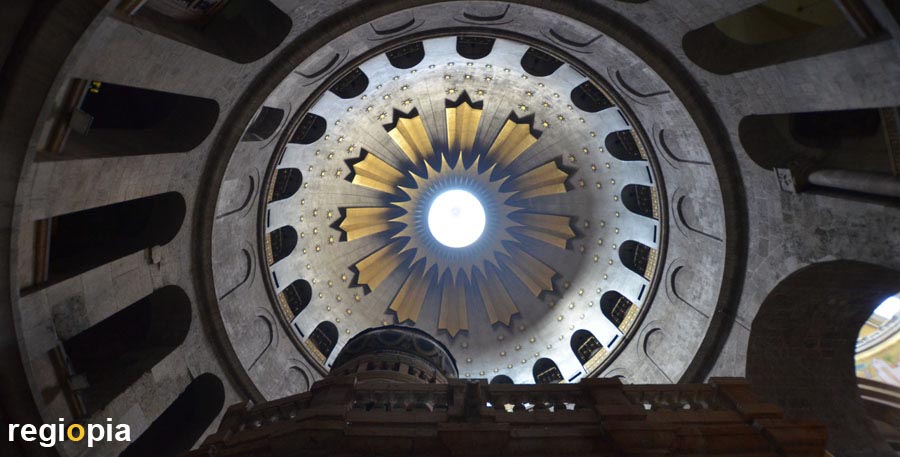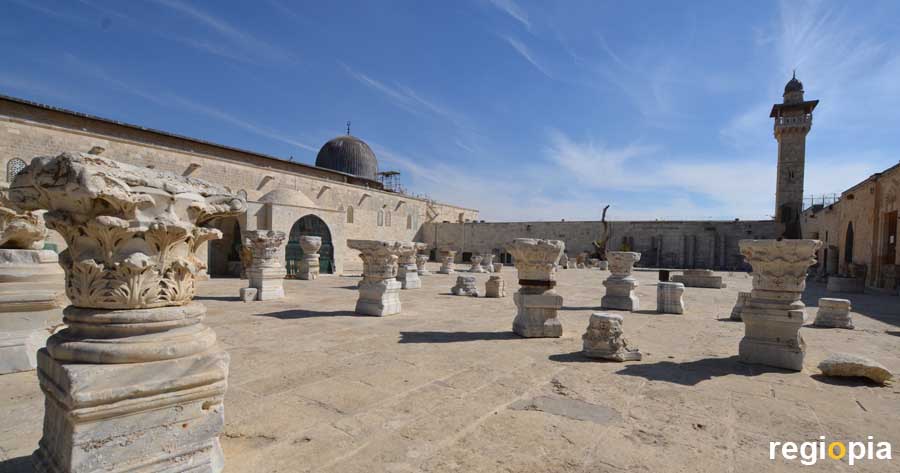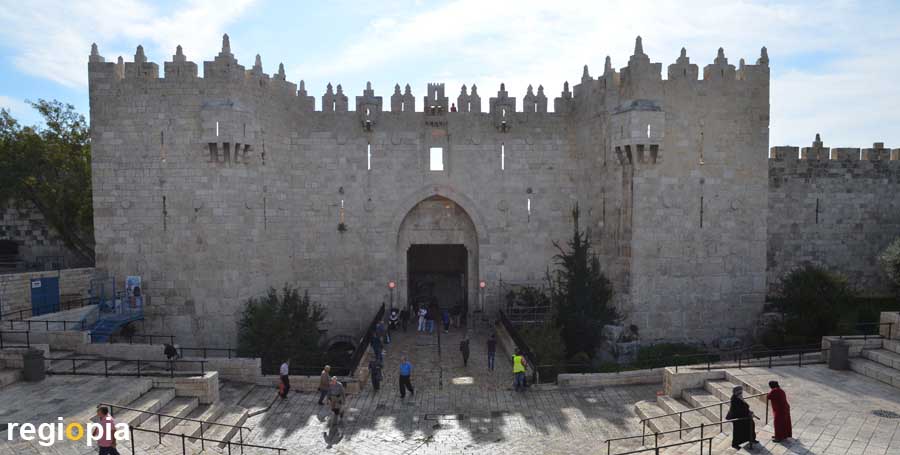
Church of the Holy Sepulchre
Jesus Christ was crucified by the Romans in 30 AD on Mount Golgotha. His body was placed in a rock tomb nearby, when he was to be embalmed, the tomb was empty. Jesus was risen from the dead and spoke to his disciples. After 40 days, Jesus ascended to heaven without leaving his body behind. The tomb of Jesus is therefore empty. In the "Church of the Holy Sepulcher" is the place where Jesus was crucified "Golgotha" and the empty rock tomb.
The first basilica was built here around 330 by roman Emperor Constantine. The Muslim Fatimid Caliph al Hakim demolished the church in 1009. Under his rule churches and synagogues were looted and destroyed to build mosques. Jews had to wear a bell around their necks. In 1040, the Church of the Holy Sepulcher was rebuilt by the Byzantine Emperor Constantine Monomachus. In 1071 Jerusalem was conquered by the Seljuk Turks, the Muslim conquerors prohibited Christians to enter Jerusalem. This ban and the years of suppression and destruction of Christian places of worship led to the Crusades to liberate the holy places from the Muslims. The Crusaders conquered Jerusalem in 1099 and extended the Church of the Holy Sepulcher several times.
Today, the Church of the Holy Sepulcher has 6 different Christian denominations, therefore, there are chapels of each faiths within the church. When you enter the Church of the Holy Sepulcher you will find the "Anointing Stone" straight ahead, on this stone Jesus is said to have lain after the crucifixion. The tomb of Jesus is to the left. Under a large dome (photo) stands the chapel (aedicula) in which the rock tomb is located. You will have to stand in line for a while to see the tomb. Opposite the aedicule is the catholic church with the "navel of the world". From the "Anointing Stone" to the right you will reach the Armenian Chapel and the St. Helena Chapel. Here a staircase leads down to the cross-finding chapel. At the entrance of the Church of the Holy Sepulcher there is a staircase on the right side leading upwards. This leads to the Golgotha rock where an orthodox chapel is at the location where Jesus was crucified. The Church of the Holy Sepulcher is the holiest place in Christianity, and although not all facts can be scientifically proven, the experts agree that this was the place where Jesus was crucified and buried.

Western Wall
The "Wailing Wall" is the remnant of the Second Jewish Temple, which was destroyed by the Romans 70 AD. From 66 AD, there was an uprising against the Roman occupation, which was terminated in 73 AD with the roman conquest of Masada. The First Temple was destroyed in 586 BC by the Babylonians. After the Second Jewish War agains Rome in 135 AD, the Jews had to leave Jerusalem.
Israel conquered the Old Town of Jerusalem in 1967 and destroyed the buildings in front of the Wailing Wall to create a sqaure. The "Western Wall" consists of two different stones, the small stones in the upper part of the wall were built by the Muslims, the lower part with the big stones dates back to the time of the Second Temple. The name "Wailing Wall" comes from the fact, that the Jews complain about the destruction of their temples. The Jews themselves call it "Western Wall". The "Wailing Wall" is also accessible to non-Jews, if one adheres to the dress code (Kippa). There is a separate area for women. Many visitors put a wish list in the cracks of the wall and hope for the fulfillment of their wishes. Orthodox Jews recite from the Book of Lamentations and sing ceremonial songs.

Dome of the Rock
The "Dome of the Rock" is not a mosque but a dome above the "Holy Rock" on the Temple Mount. On this rock Abraham was about to sacrifice his son Isaac. The rock was the center of the Jewish temple, which was destroyed by the Romans. The Jews worship the rock as a connection between heaven and earth. The Muslims worship this rock because Mohammed is said to have begun his "night journey" from here. Neither the rock nor Jerusalem are mentioned, it is merely called a distant place of worship, to which Mohammed rises from Mecca. Mohammed is said to have risen from here on his mount "Buraq", a white horse with wings and human head, into the sky. Since Islam sees itself as the successor of Judaism and Christianity, there was also a political interest to occupy the Temple Mount.
The octagonal "Dome of the Rock" was built around 691 by Caliph Abd el-Malik. The temple is covered by blue tiles, which were installed in 1545 under the rule of Suleiman I. In 1993, the Jordanian king Hussein donated 80 kilograms of gold leaf for the dome. The interior with the walkway around the rock is richly decorated. Unfortunately, non-Muslims are denied access. The access to the Temple Mount is also very restricted for non-Muslims. Access is via a wooden bridge at the "Wailing Wall". The entrance is at the security checkpoint. The flag of Israel, crosses and other religious symbols of other religions may not be taken in. Men must wear long trousers and women shoul wear a headscarf. Summer opening hours: Sun-Thu 7: 30-11: 00 and 13: 30-14: 30. In winter Sun-Thu 7: 30-10: 00 and 12: 30-13: 30. Admission is free. The opening hours can change depending on the political situation. For up-to-date information you can ask at the "Tourist Information of Jerusalem" at Jaffa Gate.

Al Aqsa Mosque
The main mosque of Jerusalem was built in 717. After the conquest of Jerusalem by the Crusaders in 1099, the mosque served as a palace. The "Al Aqsa Mosque" was repeatedly destroyed by earthquakes and rebuilt in 1200. The seemingly simple mosque is adorned in the interior with valuable ceiling frescos and beautiful mosaics. Access is denied for Non-Muslims.

Golden Menorah
The "Golden Menorah" is a faithful replica of the Menorah of the Third Temple. It is 2 m high and covered with 43 kg of gold leaf. The seven-branched candelabrum is a symbol of the Jewish faith and the state of Israel.

Hurva Synagogue
The Hurva Synagogue has a short but eventful history. The church was built in the eighteenth century by Polish emigrants, but was burnt down because of financial arrears of the community, by the money lenders. There was only a ruin left. "Hurva" is the Hebrew word for ruin. About a hundred years later, the "Hurva Synagogue" was rebuilt in Byzantine style. In the Arab-Israeli War of 1948, the Synagogue was blown up by the Jordanians because Jewish Haganah fighters were in the synagogue. In 2010, the new "Hurva Synagogue" was completed. Behind the synagogue, you can see the Sidna Omar minaret, the mosque was destroyed. Next to the Hurva Synagogue is the Ramban Synagogue, the first synagogue in Jerusalem built after the Roman expulsion of the Jews. It was founded around 1400. The "Hurva Square" is the center of the Jewish Quarter.

Western Cardo
The "Western Cardo" is part of the Byzantine shopping street of Jerusalem. In the Jewish Quarter, a part of the old 12.5 m wide trade route was reconstructed with five pillars. In Roman cities, the "Cardo" was the north-south axis and "Decumanus" the east-west axis.

Via Dolorosa
The "Via Dolorosa" is the Passion of Jesus Christ from the official residence of Pontius Pilate to the execution site of Golgotha. Jesus had to bear his cross on this way. The "Via Dolorosa" is not a road but a path through the old city of Jerusalem to the place of the crucifixion. This path has changed over the years and no longer corresponds to the original route. The "Via Dolorosa" reminds of the painful way of Jesus and is especially honored by the Catholics as a processional path. The path leads from the former castle Antonia (the seat of Pilate) to the Church of the Holy Sepulcher. The Stations of the way are marked by metal signs with Roman numbers.

Protestant Church of the Redeemer
The Protestant "Church of the Redeemer" was inaugurated in 1898 under the patronage of German Emperor Wilhelm II. The church belongs to the Protestant Jerusalem Foundation in Hanover. The neo-Romanesque Church of the Redeemer was built on the plan of the Church of St. Mary of Latina from the time of the Crusaders. The church was designed by Paul Groth, the tower was designed by Friedrich Adler. The steeple towering over Jerusalem's Old Town offers a great view on the city. The interior of the three-aisled church is unadorned and dominated by light and stone. Above the western portal, you can see the "Lamb of God" symbolizing Jesus Christ and the emblem of the German Emperor (eagle) and the Cross of the Hospitallers.

Austrian Hospice
On the corner of "Via Dolorosa" and the shopping street El Wad ha-Gai is a wooden gate that is always closed. Who wants to visit the "Austrian Hospice" must ring here. The gate opens and you reach the roof via a series of stairs (entrance fee). On the roof top you will have a beautiful panorama above Jerusalem. The "Austrian Hospice" was built in 1863 in the style of a Vienna palace. The house is used for cultural exchange and you can spend cheap nights here. In the garden there is a Viennese coffee house with cake by Julius Meinl.
http://www.austrianhospice.com/jerusalem-erleben.htm

Church of Saint Anne
The "Church of Saint Anne" was built in 1138 and stands at the place where the parents' house of Mary is said to have stood. Remains of the house from her parents Anne and Joachim, are in the crypt. The late Romanesque church is still preserved and has survived the Islamic period as a Koranic school. In 1856, the St. Anne Church was renovated by France. The church is also famous for its great acoustics. The Byzantine predecessor building was destroyed in 1009 by Caliph al Hakim. Behind the "Church of Saint Anne" you can see the remains of the Roman cisterns which also served as baths. For Christians, the church is considered the birthplace of Mary, the mother of Jesus.

Tower of David
At the "Jaffa Gate" is the main entrance to the old city of Jerusalem. Jaffa (now a district of Tel Aviv) was the port city of Jerusalem and therefore has always been the main gate of the city. Here you can see the citadel with the "Tower of David", which was a minaret a not the tower of David. The fortress was built already under the Romans, some consider this place the actual place where Jesus was condemned to death by Pilate. The citadel was expanded by the Crusaders and later under Suleiman I. In the citadel there is the historic museum "Tower of David Museum of the History of Jerusalem" (link below). At the "Jaffa Gate" are also the entrances for the "Ramparts Walk". If you want to walk along the city wall you must decide whether to go north or south. The northern entrance is to the left of the tourist information, The southern entrance is at the "Tower of David" on the outside of the city wall.

Damascus Gate
The "Damascus Gate" is the most beautiful city gate of Jerusalem. It is located in the north of the city and leads towards the Syrian capital. It is called the "pillar gate" (Bab al-Amud) by the Arabs, because a column of victory stood here, built by the Romans. The present gate dates to the times of Süleiman I and was built in 1538. Since then, the ground level has changed and you have to descend stairs to get to the gate. At the "Damascus Gate" is the border between West and East Jerusalem. Here is the bus station to the "West Bank".
ads
Map of sights in Jerusalem
ads
Travel Guide Jerusalem
Welcome to Jerusalem
Jerusalem is the center of Judaism and Christianity, but is also revered by the Muslims as a "holy city". Jerusalem has about 850,000 inhabitants (about 500,000 of which are Jews) and is the capital of Israel. But Jerusalem is also seen by the Palestinians as the future capital of an independent state. The city is divided into West Jerusalem (Israel) and East Jerusalem (Palestine). The old city belongs to East Jerusalem, but Israel has control over the whole of Jerusalem and also over the "West Bank". The Jewish part of the old town is separated from the other districts by security gates. For tourists, these gates are no obstacles.
ads
ads


